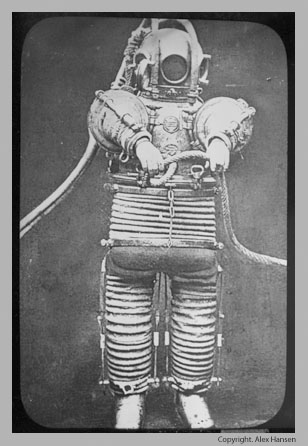The brothers Carmagnolle developed their armoured dress in 1882 and then came other designers including Pelkey, Hemenger and Carey in 1891. In 1894 two Australian inventors had developed their version of the Armoured diving suit. They were John Buchanan and Alexander Gordon, who came from Melbourne. The design was common to several of the other types in that the construction was based on spiral wires. These wire frames were covered with a waterproof material. This design was later improved by Alexander Gordon by fixing the dress to the helmet and other standing parts. He now incorporated jointed radius rods to the limb parts. The result was a flexible suit able to withstand high pressure at depth. The suit was made by Messrs Siebe Gorman and Co. at their Westminster Bridge Road works. The suit was trialed in Scotland in 1898. You may recognise the picture of the suit as it was later to be used in the John Player cigarette card series in the 1930s.
With special thanks to Alex Hansen for providing us with the photograph which was from a glass slide used in the publication Deep Diving and Submarine Operations.
© 2006 by Diving Heritage
mailto:info@divingheritage.com
